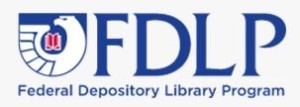The Indiana State Library provides services and expertise on a variety of subjects to Hoosiers across the state. One subject ISL can help patrons with is locating federal information. The State Library participates in the Federal Depository Library Program, which is a government program created to make U.S. federal government publications publicly available at no cost. There are 33 libraries in the state that participate in this program. ISL serves as the Regional Depository Library for Indiana.
 FDLP libraries provide access to official federal government information, but also employ a library staff member with an expertise on the subject to aid research. At ISL, the position is part of the Reference & Government Services Division. The federal depository coordinator – or librarian – can assist researchers in historical research, politics, law or genealogy, but that only represents a fraction of the information that is publicly available. The U.S. government offers a wealth of information that is easily searchable online. It can be challenging to locate specific information. For current information, it is likely to be found by searching two resources: govinfo.gov and usa.gov.
FDLP libraries provide access to official federal government information, but also employ a library staff member with an expertise on the subject to aid research. At ISL, the position is part of the Reference & Government Services Division. The federal depository coordinator – or librarian – can assist researchers in historical research, politics, law or genealogy, but that only represents a fraction of the information that is publicly available. The U.S. government offers a wealth of information that is easily searchable online. It can be challenging to locate specific information. For current information, it is likely to be found by searching two resources: govinfo.gov and usa.gov.
 Govinfo.gov is the one-stop site for authentic information published by the government. For those looking for a particular law, report, Congressional Committee material or any official publications from the three branches of government, govinfo.gov is the resource to use. The website allows users to search for specific legislation – like the recent Heroes Act – or browse for information by searching through collections, author, committees or date. GovInfo provides individuals access to official published government documents.
Govinfo.gov is the one-stop site for authentic information published by the government. For those looking for a particular law, report, Congressional Committee material or any official publications from the three branches of government, govinfo.gov is the resource to use. The website allows users to search for specific legislation – like the recent Heroes Act – or browse for information by searching through collections, author, committees or date. GovInfo provides individuals access to official published government documents.
 USA.gov is the official web portal of the United States government, and essentially serves as an information hub that connects individuals to information relating to the services offered by the federal government. Individuals can search every U.S. government website through usa.gov or learn about popular government programs and services. They are all organized by topic. USA.gov can help researchers contact members of Congress, check on your stimulus check, get COVID-19 resources, find government jobs and so much more.
USA.gov is the official web portal of the United States government, and essentially serves as an information hub that connects individuals to information relating to the services offered by the federal government. Individuals can search every U.S. government website through usa.gov or learn about popular government programs and services. They are all organized by topic. USA.gov can help researchers contact members of Congress, check on your stimulus check, get COVID-19 resources, find government jobs and so much more.
With the breadth of information provided by our government, the federal documents coordinator can help researchers navigate the information overload. ISL staff can help researchers identify valuable government resources and help patrons on how to search a particular resource. Researchers can call, email, visit, chat or submit a LibAnswer question for assistance. Staff members have put together subject guides and presented webinars to help improve literacy of government information. As a FDLP library, the Indiana State Library is committed to ensuring Hoosiers can access government information and help navigate the wide range of government information available.
This blog post was written by Indiana State Library federal documents coordinator Brent Abercrombie. For more information, contact the Reference and Government Services at 317-232-3678 or via “Ask-A-Librarian.”


